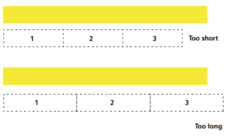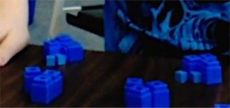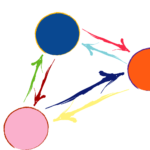Research
Research Articles and Conference Papers
2021
See our new curriculum page for updated resources and research!
2020
 Hunt, J. H., Martin, K., Khounmeuang, A., Silva, J., Patterson, B., & Welch-Ptak, J. (2020). Design, Development, and Initial Testing of Asset-Based Intervention Grounded in Trajectories of Student Fraction Learning. Learning Disability Quarterly, 0731948720963589.
Hunt, J. H., Martin, K., Khounmeuang, A., Silva, J., Patterson, B., & Welch-Ptak, J. (2020). Design, Development, and Initial Testing of Asset-Based Intervention Grounded in Trajectories of Student Fraction Learning. Learning Disability Quarterly, 0731948720963589.
We report the development and initial testing of an intervention designed to increase access to and advancement in conceptual understanding. Our asset-based theory of change—a tested and confirmed learning trajectory of fraction concepts of students with LDs grounded in student-centered instruction—served as the basis for our multistage scientific design process. The positive outcomes support continued exploration and expansion of a new framework for supplemental intervention grounded in trajectories of student learning.
 Hunt. J.H. & Silva, J. (in press). Emma’s negotiation of number: Implicit intensive intervention. Journal for Research in Mathematics Education.
Hunt. J.H. & Silva, J. (in press). Emma’s negotiation of number: Implicit intensive intervention. Journal for Research in Mathematics Education.
We investigated how one elementary school child with working memory differences made sense of number as composite unit and advanced her reasoning. We uncovered four shifts in the child’s real-time negotiation of number over time: (a) Initial “twos” and symmetry to consider counting on, (b) Participatory awareness of ten/use of algorithmic knowledge, (c) Break apart and growing anticipation of tacit counting, and (d) Advanced participatory tacit double counting. We found a link between Emma’s participatory knowledge and the extent to which her enacted activity met her goals for solving the problem more than her current “knowing”. Implications regarding a possible proof of concept toward implicit, intensive instruction are shared.
2019
Hunt, J.H., MacDonald, B. & Silva, J. (2019). Gina’s Mathematics: Thinking, “tricks”, or teaching? Journal of Mathematical Behavior, 10007.
We present analysis of multiple student-centered teaching sessions. “Gina” (student with LD) improves her concept of one-half in novel tasks. She coordinates units of one-half with a referent whole; reflects on her own actions. We argue children with LDs need opportunities to make sense of their own mathematical thinking.
Hunt, J.H., Silva, J., & Lambert, R. (2019). Empowering students with specific learning disabilities: Jim’s concept of unit fraction. Journal of Mathematical Behavior, 56, 100738.
Cognitive differences have historically led to deficit assumptions concerning the mathematical experiences that children with learning disabilities (LD) can access. We argue that the problem can be located not within children but instead as a mismatch between features of instruction and children’s unique learning abilities. We outline one student’s affordances and constraints of developing fraction knowledge. We adapted our teaching to respond to the students’ unique ways of reasoning rather than forcing him to think our way. Three key teaching moves supported growth in the student’s reasoning.
2018
Lambert, R., Tan, P., Hunt, J.H., & Candela, A.C. (2018). Rehumanizing the mathematics education of students with disabilities: Critical perspectives on research and practice. Investigations in Mathematics Learning, 10(3), 129-132.
2017
Hunt, J.H. & Tzur, R. (2017). Where is difference? Processes of mathematical remediation through a constructivist lens. Journal of Mathematical Behavior, 48, 62-76.
Results of this study challenge the deficit perspective on mathematical knowing and learning for children labeled as LD, focusing on their struggles not as a within student attribute, but rather as within teacher-learner interactions. Data analysis from two case studies showed three main types of interactions, and how they changed over time, which seemed to support the students’ learning: Assess, Cause and Effect Reflection, and Comparison/Prediction Reflection. We argue for an intervention in interaction that occurs in the instructional process for students with LD, which should replace attempts to “fix” students’ deficiencies.
2016
Hunt, J.H., Welch-Ptak, J., & Silva, J. (2016). Initial understandings of fraction concepts evidenced by students with mathematics learning disabilities and difficulties: A framework. Learning Disabilities Quarterly, 39(4), 213-225.
The present study extends current literature by presenting key understandings of fractions, documented through problem-solving activity, language, representations, and operations, evidenced by students with learning disabilities and mathematics difficulties as they engaged with equal sharing problems. Clinical interviews were conducted with 43 students across the second, third, fourth, and fifth grades. Results of the study suggest that students with LD hold similar informal notions of key understandings of fractions as students with mathematics difficulties. A framework is presented for educators to use when working to uncover students’ initial conceptions.
 Hunt, J.H., Tzur, R., & Westenskow, A. (2016). Evolution of unit fraction conceptions in two fifth grade students with learning disabilities: An exploratory study. Mathematical Thinking and Learning, 18(3), 182-208.
Hunt, J.H., Tzur, R., & Westenskow, A. (2016). Evolution of unit fraction conceptions in two fifth grade students with learning disabilities: An exploratory study. Mathematical Thinking and Learning, 18(3), 182-208.
This exploratory study showed how the conception of unit fractions (1/n) was constructed through the mathematical activity of two fifth grade girls with LDs. We analyze data segments from episodes conducted during a teaching experiment grounded in the activity of iterating estimates of one person’s equal share. Our findings include four distinct conceptual stages: (1) No Conception of the Nature of Adjustment to the Magnitude of a Unit Fraction, (2) Evolving Anticipation of the Nature of Adjustment but not of its Relative Amount, (3) Anticipation of the Nature of Adjustment with an Evolving Partial Amount, and (4) a Dual Anticipation of the Nature and Amount of Adjustment. Educators might consider these stages when evaluating students’ understandings in real time.
2015
 Hunt, J.H., Westenskow, A., Silva, J., & Welch-Ptak, J. (2015). Levels of participatory conception of fraction quantity along a purposively sequenced series of equal sharing tasks: Stu’s trajectory. Journal of Mathematical Behavior, 41, 45-67.
Hunt, J.H., Westenskow, A., Silva, J., & Welch-Ptak, J. (2015). Levels of participatory conception of fraction quantity along a purposively sequenced series of equal sharing tasks: Stu’s trajectory. Journal of Mathematical Behavior, 41, 45-67.
There is a need for research that provides a characterization of key understandings (KUs) of fractional quantity evidenced by children with learning disabilities (LD) and how growth of conceptual knowledge may occur within these children’s own reasoning. We present KUs of fractional quantity, evidenced through problem solving strategies, observable operations, and naming/quantification of one fifth grader with LD before, during, and after seven instructional sessions situated in equal sharing. We utilized a characterization of evolving fraction conceptions developed from research of children without disabilities that was ultimately productive in facilitating conceptual advances of the child with LD. Educators might use this case as an example of how to sequence equal sharing tasks to promote reasoning from what children CAN think and do.
2014
 Hunt, J.H. & Empson, S. (2014). Exploratory study of informal strategies for equal sharing problems of students with learning disabilities. Learning Disability Quarterly, 1-13.
Hunt, J.H. & Empson, S. (2014). Exploratory study of informal strategies for equal sharing problems of students with learning disabilities. Learning Disability Quarterly, 1-13.
This exploratory study extends existing literature by documenting the strategies students with LD use when solving fraction problems. Clinical interviews were conducted with 10 students across the third, fourth, and fifth grades (N = 10). Results indicate students with LD used similar strategies as previously reported in research involving non-LD students. Researchers suggest the nature of conceptual gaps students with LD display in their understanding of fractions originates from a malleable source.




